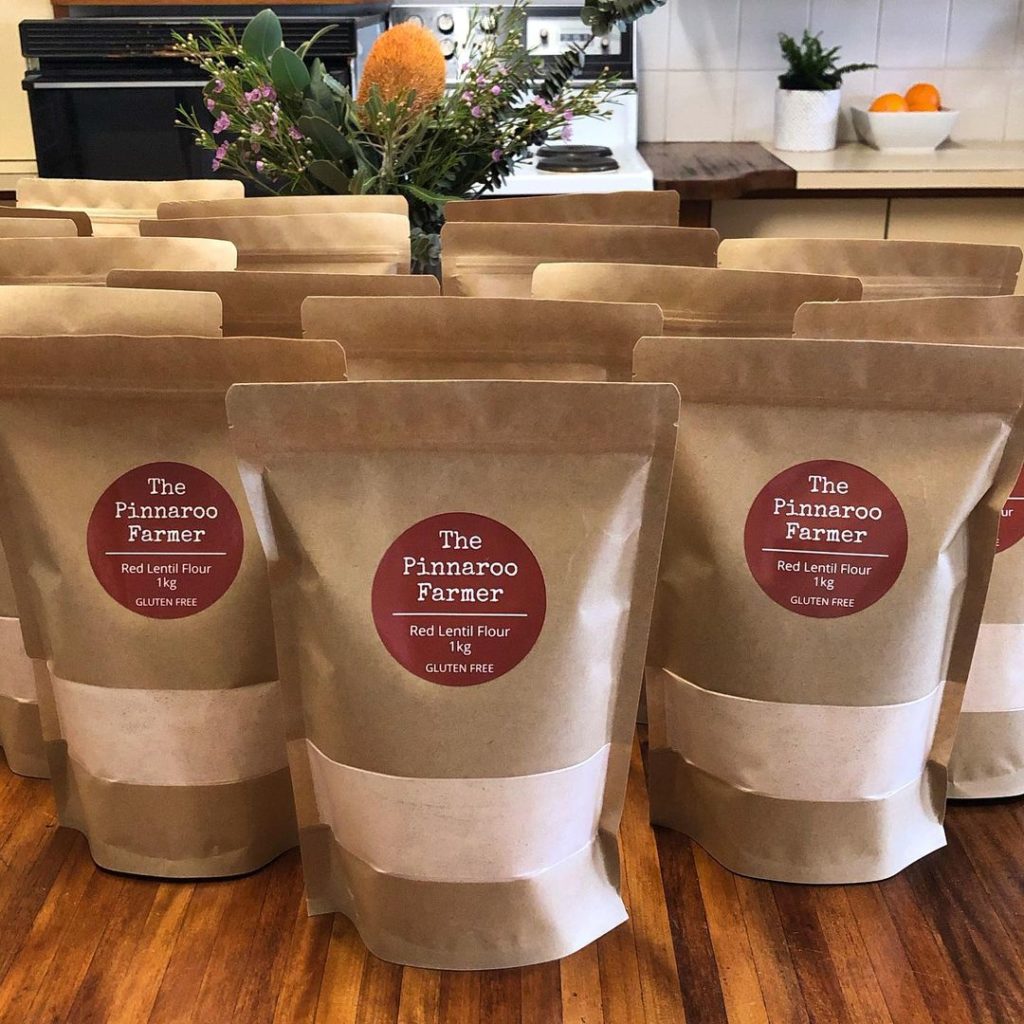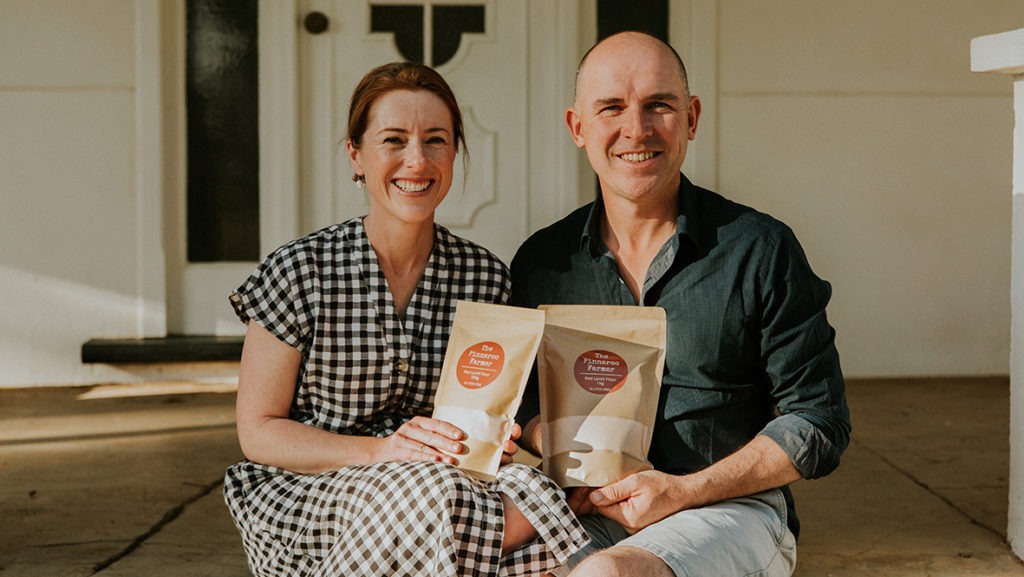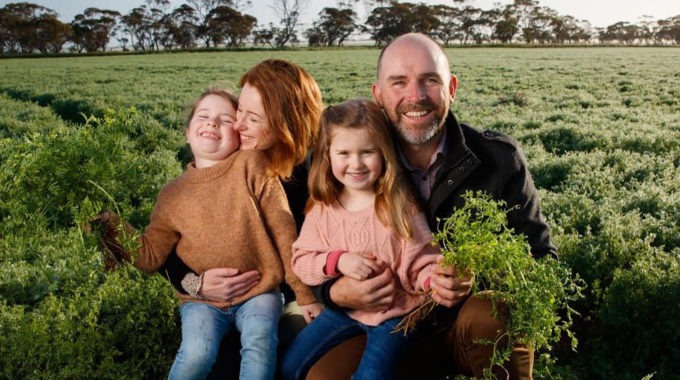Lentil as anything: The Pinnaroo Farmer
Eativity meets the enterprising family behind The Pinnaroo Farmer, the Adelaide producers who discovered that when life gives you lemons, you should make lentil flour.
Fruit and vegies aren’t the only crops that get rejected for looking a bit funny. Even legumes like lentils can be turned down due to visual specifications. This is despite the fact that a few cracks or dents have no impact on the end product’s taste or nutritional value.
While most premium lentils grown here in Australia are destined for the export market, any that are chipped, cracked, dented or discoloured are turned away. They often end up as animal feed, fetching the grower a far lower price.
Last year, farmers Phillipa and Skeet Lawson from Pinnaroo in South Australia’s Mallee region found themselves with a larger than usual surplus of rejected lentils after what had been a particularly tough couple of seasons. The pair run a wheat, barley, canola and lentil operation; they grow red lentils as part of their farm’s cropping rotation. These legumes play a key role in nitrogen-fixing and help the soil to conserve moisture.
Two consecutive years of severe frosts combined with a particularly dry finishing stage – where there’s less water in the plant at the end of the growing season due to low rainfall – had left the Lawsons with more wrinkly and brittle lentils. These cracked and chipped more easily when they were put through the harvester.
“It was so frustrating,” Phillipa says. “We can control some things, such as settings on the harvester, but once you’ve done that it’s out of your control; it just came down to the way the season finished. And those two years of severe frost were just so bad, so the poor plants had really been put through the wringer.”

When life gives you lemons, make lentil flour
The family had already received a blow to their bottom line in 2017, when India – a key export market for Australian lentils – imposed large tariffs of 30 percent on lentil imports.
“It reduced the price of lentils quite significantly,” Phillipa says. “And of course, then we were left with all these chipped grains. It was just such a waste. My husband and I were trying to think – what can we do with this? We just had no idea what to do.”
In a triple whammy for the Lawson family, their youngest daughter also started having eating problems. She became very fussy with her food and refused to eat meat. She also began to experience poor sleeping patterns. Lawsons were advised that this was due to her nutritional intake. She needed more protein in her diet.
The worried parents struck upon the idea of making flour out of their excess lentils. The legumes are high in protein, and therefore an excellent meat alternative.
“Our first attempt was just in a Kitchen Wizz,” Phillipa says with a laugh. “It’s funny because they’re quite a hard seed, but we were thinking it would be enough to make it work. It wasn’t. It was so gritty, it was like sand.”

No run of the mill idea
The Lawsons decided to invest in a small domestic mill. After some trial and error, they managed to produce lentil flour with a very fine consistency. They added this flour to gravies, pizza bases, pancakes and baked goods, which their daughter happily ate. The Lawsons then realised they might also have hit upon the ideal way to use their excess lentils.
“There was absolutely nothing wrong with them,” Phillipa says. “We had nutrient testing done. It showed that even if the lentil has been cracked or dented, there’s absolutely nothing wrong with its nutritional profile. In fact, the protein is a fraction higher than a normal lentil, grown in normal conditions.”
Phillipa and Skeet also consulted with Drew Portman, a scientist from Charles Sturt University who was researching the nutritional benefits of lentil flour when used in baked goods. His findings showed that the benefits of the flour remained even after it was heated and cooked. The Lawsons have also had their flour tested for traces of gluten in an Adelaide laboratory to ensure their product is gluten-free.

Flour power
In early 2020, the Lawsons began looking into the Australian lentil market and the growing plant-based trend. Phillipa took part in a start-up accelerator program called Farmers2Founders, an entrepreneurship program designed to help Australian primary producers take advantage of emerging technologies and new business models. The couple decided to commercialise their idea – in the middle of a pandemic, no less – and The Pinnaroo Farmer was born. The business now sells red lentil flour directly to customers through an online shop, at a local bakery and through a wholefoods store in Adelaide.
“I had no idea what the response would be when we started this,” Phillipa admits. “We don’t eat a lot of lentils as Australians; it’s not a staple food here. So I was curious to see how the market would respond to a product like this.”
Respond it did. Within the first three months, The Pinnaroo Farmer had sold more than 250 kilos of flour. After the family appeared on an episode of ABC’s Landline in mid-March, they were absolutely inundated with orders, selling about 800 kilos of flour.
“We only just finished posting them all out last week,” Phillipa says. “It was unbelievable.”
As well as overwhelmingly positive consumer feedback, The Pinnaroo Farmer also received a great deal of interest from food manufacturers at a recent trade show in Adelaide. Phillipa believes that the appeal of their red lentil flour product comes from the fact that it’s Australian-made, it’s highly nutritious and it’s gluten-free.
“I’d say about 70 percent of people who purchase from us would buy purely for the nutritional quality,” she says. “The other 30 percent are looking for a healthier gluten-free flour alternative. Some gluten-free flours are very highly processed.
“The other appeal is that it’s Australian. People are really craving access to Australian-grown food. Not just manufactured in Australia but grown in Australia.”

The pride of Pinnaroo
At the time of writing, The Pinnaroo Farmer had sold around two and a half tonnes of red lentil flour. The Lawsons are now also working with a research and development expert, with plans to launch new lentil products later this year. The ultimate aim is that the business will become so successful that other lentil farmers in the area will be able to start selling their excess lentils to The Pinnaroo Farmer.
“That’s why we called our business The Pinnaroo Farmer,” Phillipa says. “We thought, if this goes well and we get a lot of market traction and a lot of interest from industry and consumers, we’ll outgrow our farm. So we’ll need to have other farmers to purchase off.
“Eventually, our vision is that this won’t just be about me and my husband and our farm. We want to see Pinnaroo as the red lentil-growing region in Australia.”
You can find out more, and purchase The Pinnaroo Farmer red lentil flour, at thepinnaroofarmer.com.au









